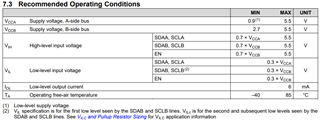Hi, team.Please follow datasheet interpretation.
Q1: If system device use VOL=0.4V,
which of the datasheet TCA9517 side should
Look at:(Vccb=3.3)
VIL(=0.3*Vccb=0.99V(max))
or
VILC(=0.4V(typ))
Q2:I think VIL would be fine, but in what kind of situation should VILC be used.




